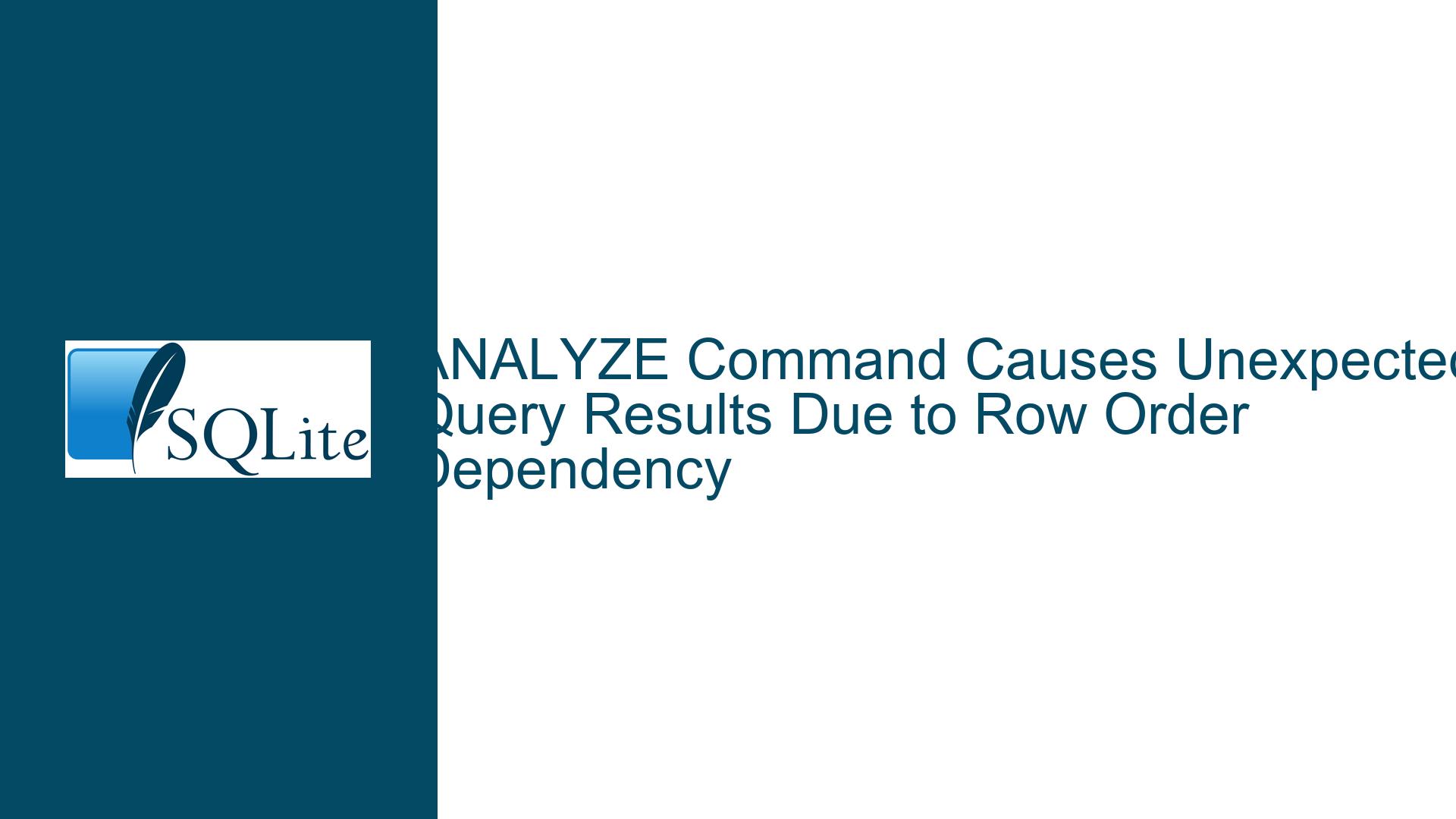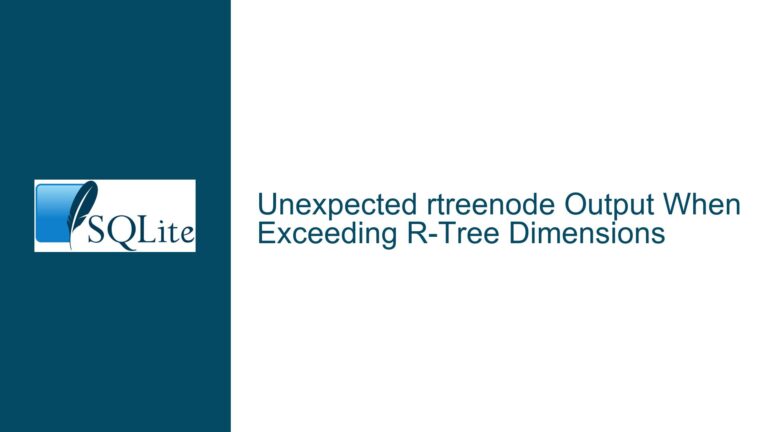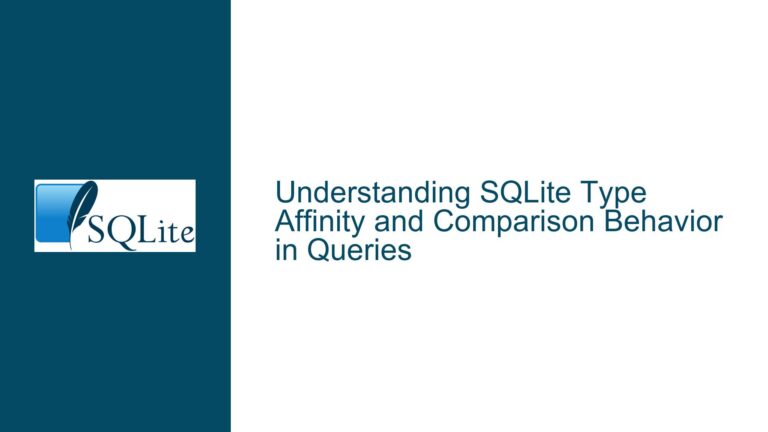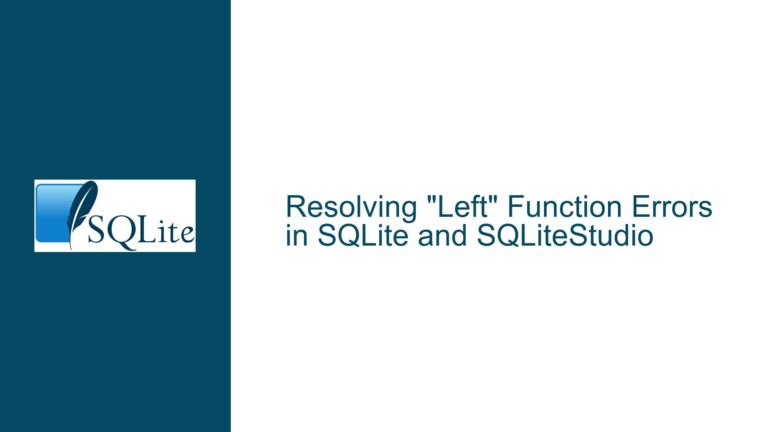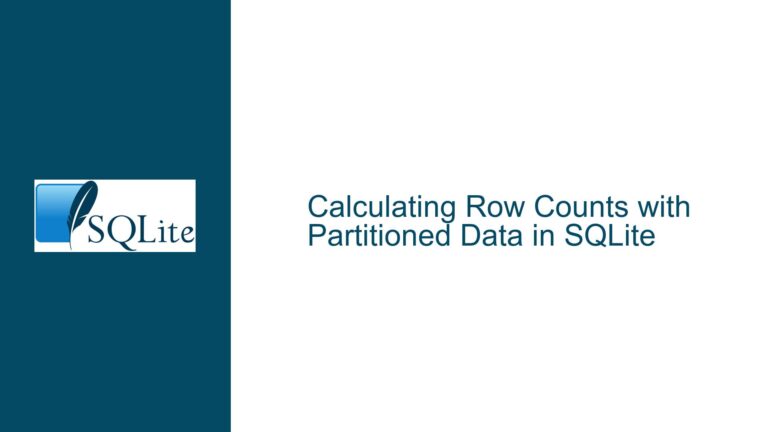ANALYZE Command Causes Unexpected Query Results Due to Row Order Dependency
Issue Overview: ANALYZE-Induced Row Order Changes Affect GROUP_CONCAT and Numeric Casting
The core issue revolves around how the SQLite ANALYZE command influences query planner decisions, which inadvertently alters the implicit row order processed by the GROUP_CONCAT() function. This change in row order propagates through type casting operations and logical comparisons, leading to unexpected results in aggregate calculations and WHERE clause evaluations. The problem manifests when a query depends on implicit row ordering for string aggregation and subsequent numeric conversion, creating non-deterministic outcomes depending on whether statistics are collected via ANALYZE.
Example Scenario Breakdown:
- A temporary table
t1is created with a single columnc0storing heterogeneous data types (integer1and empty string''). - After executing
ANALYZE temp, SQLite generates statistical metadata for the temporary schema, enabling the query planner to optimize joins and scan orders. - A subquery uses
GROUP_CONCAT(t1.c0)to aggregate values fromt1, joined with a derived table that applies aCAST(t1.c0 AS INTEGER)operation. - The aggregated string result (e.g.,
',1,'or'1,,') is cast toNUMERICin theWHEREclause, producing different numeric values (0or1) based on concatenation order. - The outer query’s
COUNT(*)result changes from1to2depending on whetherANALYZEwas executed, as the aggregated string’s numeric interpretation shifts.
Critical Observations:
- The
GROUP_CONCAT()function does not guarantee row order unless explicitly ordered viaORDER BY. ANALYZEalters the query planner’s choice of index scans or table scan orders, indirectly affecting the sequence in which rows are processed.- Implicit casting of aggregated strings to numeric types introduces fragility:
',1,'casts to0(due to leading non-numeric characters), while'1,,'casts to1(as leading digits are parsed until non-digit characters).
Possible Causes: Query Planner Optimization, Implicit Casting, and Non-Deterministic Aggregation
1. ANALYZE-Driven Query Plan Changes
The ANALYZE command collects statistics about table content and index selectivity, which the SQLite query planner uses to optimize execution strategies. When statistics are available:
- The planner may reorder joins or switch between index scans and full table scans.
- Row retrieval order in absence of
ORDER BYclauses becomes dependent on physical storage or index structures. - In the test case,
ANALYZE tempcauses the subquery’s derived table (temp_table) to be scanned in an order that places the integer value1before the empty string'', altering theGROUP_CONCAT()output.
2. GROUP_CONCAT() Order Sensitivity
The GROUP_CONCAT() function aggregates values in the order rows are processed by the query engine. Without an explicit ORDER BY:
- The concatenation order is determined by low-level storage details (e.g., rowid order) or index traversal paths.
ANALYZEindirectly influences this order by changing the query planner’s access strategy. For example, a full table scan might process rows in insertion order, while an index scan could process them in indexed column order.
3. Type Casting Ambiguity in WHERE Clauses
The CAST operations in the query introduce two vulnerabilities:
- Implicit String-to-Integer Conversion: The subquery’s
CAST(t1.c0 AS INTEGER)evaluates to1for the integer value1and0for the empty string''. However, theOR 1clause makes this predicate always true, rendering theCASToperation irrelevant in filtering but still executed. - Aggregated String-to-Numeric Conversion: The outer query’s
CAST(temp_table.c0 AS NUMERIC)interprets the concatenated string. The value',1,'is parsed as0(stopping at the first non-digit), while'1,,'is parsed as1. This discrepancy directly impacts theNOT BETWEENcondition’s effectiveness.
Troubleshooting Steps, Solutions & Fixes: Enforcing Determinism and Resolving Type Ambiguity
Step 1: Eliminate Implicit Row Order Dependencies
Problem: Reliance on GROUP_CONCAT() without ORDER BY makes the query sensitive to query plan changes.
Solution:
- Add an explicit
ORDER BYclause to theGROUP_CONCAT()function to ensure deterministic concatenation:SELECT GROUP_CONCAT(t1.c0 ORDER BY rowid) FROM ... - Use
rowid(for tables without primary keys) or an explicit sort key (e.g., an autoincrementing column) to stabilize the aggregation order.
Example Fix:
SELECT GROUP_CONCAT(t1.c0 ORDER BY rowid) FROM t1, (...) AS temp_table ...
Step 2: Resolve Type Casting Ambiguities
Problem: Mixing data types in c0 (integer and empty string) leads to unpredictable casting outcomes.
Solutions:
- Normalize Data Types: Enforce a consistent data type for
c0usingCHECKconstraints or schema design:CREATE TEMP TABLE t1 (c0 INTEGER CHECK (c0 IS NULL OR typeof(c0) IN ('integer', 'real'))); - Explicitly Handle Empty Strings: Replace
''withNULLor a default numeric value during insertion:INSERT INTO t1 VALUES (1), (NULL); - Use COALESCE for Predictable Casting:
CAST(COALESCE(t1.c0, 0) AS INTEGER)
Step 3: Avoid Query Planner-Induced Non-Determinism
Problem: ANALYZE changes query plans, affecting row processing order.
Solutions:
- Disable Query Planner Optimizations Temporarily: Use
PRAGMA optimize=0orPRAGMA analysis_limit=0to prevent automatic use of statistics. - Use Index Hints: Force a specific index scan order with
INDEXED BY(not recommended for long-term maintenance). - Materialize Intermediate Results: Store subquery results in a temporary table with explicit ordering:
CREATE TEMP TABLE temp_table AS SELECT t1.c0 FROM t1 WHERE ... ORDER BY rowid;
Step 4: Rewrite the Query to Remove Ambiguous Constructs
Problem: The original query uses a cross join and a redundant OR 1 predicate, complicating execution logic.
Solutions:
- Replace Cross Join with Explicit Join: Use
INNER JOINwith explicit conditions. - Simplify the Subquery Logic: Remove the tautological
OR 1clause.
Optimized Query Example:
SELECT COUNT(*)
FROM t1
WHERE (t1.c0 + (
SELECT GROUP_CONCAT(t1.c0 ORDER BY rowid)
FROM t1
INNER JOIN (
SELECT t1.c0 AS c0
FROM t1
WHERE CAST(t1.c0 AS INTEGER) -- OR 1 removed
) AS temp_table ON t1.c0 NOT BETWEEN 0 AND CAST(temp_table.c0 AS NUMERIC)
)) IS NOT NULL;
Step 5: Validate Schema Design and Data Integrity
Problem: Mixing data types in a column without constraints leads to runtime casting errors.
Solutions:
- Strict Typing: Define columns with explicit types and
CHECKconstraints. - Data Validation on Insertion: Use triggers to reject invalid data:
CREATE TRIGGER t1_validate BEFORE INSERT ON t1 BEGIN SELECT RAISE(ABORT, 'Invalid value') WHERE NEW.c0 <> '' AND CAST(NEW.c0 AS INTEGER) IS NULL; END;
Step 6: Test with and Without ANALYZE
Procedure:
- Execute the query without
ANALYZEand record the result. - Run
ANALYZEand execute the query again. - If results differ, inspect query plans using
EXPLAIN QUERY PLANto identify join order changes. - Use deterministic sorting or materialized views to eliminate variances.
Example Plan Comparison:
-- Without ANALYZE
EXPLAIN QUERY PLAN
SELECT GROUP_CONCAT(t1.c0) FROM t1, (...) AS temp_table ...;
-- With ANALYZE
ANALYZE temp;
EXPLAIN QUERY PLAN
SELECT GROUP_CONCAT(t1.c0) FROM t1, (...) AS temp_table ...;
Final Recommendation:
Queries relying on implicit row order or ambiguous type conversions are inherently fragile. Always:
- Use
ORDER BYwithGROUP_CONCAT(). - Enforce strict data typing.
- Avoid cross joins unless intentional.
- Test queries under different optimizer states (with/without
ANALYZE).
By addressing these factors, developers can ensure stable results across varying SQLite environments and optimizer states.
